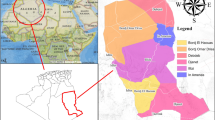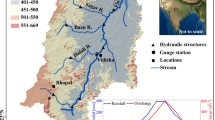Abstract
Drought is a harmful natural disaster with various negative effects on many aspects of life. In this research, short-term meteorological droughts were predicted with hybrid machine learning models using monthly precipitation data (1960–2020 period) of Sakarya Meteorological Station, located in the northwest of Turkey. Standardized precipitation index (SPI), depending only on precipitation data, was used as the drought index, and 1-, 3-, and 6-month time scales for short-term droughts were considered. In the prediction models, drought index was predicted at t + 1 output variable by using t, t − 1, t − 2, and t − 3 input variables. Artificial neural networks (ANNs), adaptive neuro-fuzzy inference system (ANFIS), Gaussian process regression (GPR), support vector machine regression (SVMR), k-nearest neighbors (KNN) algorithms were employed as stand-alone machine learning methods. Variation mode decomposition (VMD), discrete wavelet transform (DWT), and empirical mode decomposition (EMD) were utilized as pre-processing techniques to create hybrid models. Six different performance criteria were used to assess model performance. The hybrid models used together with the pre-processing techniques were found to be more successful than the stand-alone models. Hybrid VMD-GPR model yielded the best results (NSE = 0.9345, OI = 0.9438, R2 = 0.9367) for 1-month time scale, hybrid VMD-GPR model (NSE = 0.9528, OI = 0.9559, R2 = 0.9565) for 3-month time scale, and hybrid DWT-ANN model (NSE = 0.9398, OI = 0.9483, R2 = 0.9450) for 6-month time scale. Considering the entire performance criteria, it was determined that the decomposition success of VMD was higher than DWT and EMD.














Similar content being viewed by others
Data availability
The datasets used or analyzed during the current study are available from the corresponding author on reasonable request.
Code availability
The codes were developed from the MATLAB website.
References
Akbar Jalilzadnezamabad (2019) Forecasting palmer drought severity index using hybrid wavelet-heuristic models. Istanbul Technical University
Başakın EE, Ekmekcioğlu Ö, Çıtakoğlu H, Özger M (2022) A new insight to the wind speed forecasting: robust multi-stage ensemble soft computing approach based on pre-processing uncertainty assessment. Neural Comput Appl 34. https://doi.org/10.1007/s00521-021-06424-6
Başakın EE, Ekmekcioğlu Ö, Ozger M (2019) Drought analysis with machine learning methods. Pamukkale Univ J Eng Sci 25:985–991. https://doi.org/10.5505/pajes.2019.34392
Belayneh A, Adamowski J, Khalil B (2016) Short-term SPI drought forecasting in the Awash River Basin in Ethiopia using wavelet transforms and machine learning methods. Sustain Water Resour Manag 2:87–101. https://doi.org/10.1007/s40899-015-0040-5
Citakoglu H (2015) Comparison of artificial intelligence techniques via empirical equations for prediction of solar radiation. Comput Electron Agric 118. https://doi.org/10.1016/j.compag.2015.08.020
Citakoglu H (2017) Comparison of artificial intelligence techniques for prediction of soil temperatures in Turkey. Theor Appl Climatol 130. https://doi.org/10.1007/s00704-016-1914-7
Citakoglu H (2021) Comparison of multiple learning artificial intelligence models for estimation of long-term monthly temperatures in Turkey. Arab J Geosci 14. https://doi.org/10.1007/s12517-021-08484-3
Citakoglu H, Minarecioglu N (2021) Trend analysis and change point determination for hydro-meteorological and groundwater data of Kizilirmak basin. Theor Appl Climatol 145. https://doi.org/10.1007/s00704-021-03696-9
Cortes C, Vapnik V (1995) Support vector networks. Mach Learn 20:293–297
Demir V (2022a) Trend analysis of lakes and sinkholes in the Konya Closed Basin, in Turkey. Nat Hazards. https://doi.org/10.1007/s11069-022-05327-6
Demir V (2022b) Enhancing monthly lake levels forecasting using heuristic regression techniques with periodicity data component: application of Lake Michigan. Theor Appl Climatol 148:915–929. https://doi.org/10.1007/s00704-022-03982-0
Dragomiretskiy K, Zosso D (2014) Variational mode decomposition. IEEE Trans Signal Process 62. https://doi.org/10.1109/TSP.2013.2288675
Fadaei-Kermani E, Barani GA, Ghaeini-Hessaroeyeh M (2017) Drought monitoring and prediction using K-nearest neighbor algorithm. J AI Data Min 5:319–325. https://doi.org/10.22044/JADM.2017.881
Fadaei-Kermani E, Ghaeini-Hessaroeyeh M (2020) Fuzzy nearest neighbor approach for drought monitoring and assessment. Appl Water Sci 10:130. https://doi.org/10.1007/s13201-020-01212-4
Haktanir T, Citakoglu H (2015) Closure to “Trend, independence, stationarity, and homogeneity tests on maximum rainfall series of standard durations recorded in Turkey” by Tefaruk Haktanir and Hatice Citakoglu. J Hydrol Eng 20. https://doi.org/10.1061/(ASCE)HE.1943-5584.0001246
Haktanir T, Citakoglu H (2014) Trend, independence, stationarity, and homogeneity tests on maximum rainfall series of standard durations recorded in Turkey. J Hydrol Eng 19:05014009. https://doi.org/10.1061/(asce)he.1943-5584.0000973
Haykin S (1998) Neural networks: a comprehensive foundation
Huang NE, Shen Z, Long SR et al (1998) The empirical mode decomposition and the Hilbert spectrum for nonlinear and non-stationary time series analysis. Proc R Soc London Ser A Math Phys Eng Sci 454:903–995. https://doi.org/10.1098/rspa.1998.0193
Jang JSR (1993) ANFIS: adaptive-network-based fuzzy inference system. IEEE Trans Syst Man Cybern 23:665–685
Kaur A, Sood SK (2020) Deep learning based drought assessment and prediction framework. Ecol Inform 57:101067. https://doi.org/10.1016/j.ecoinf.2020.101067
Khanmohammadi N, Rezaie H, BehmaneshJavad, Khanmohammadi N (2022) Investigation of drought trend on the basis of the best obtained drought index. Water Resour Manag. https://doi.org/10.1007/s11269-022-03086-4
Kisi O, Cimen M (2011) A wavelet-support vector machine conjunction model for monthly streamflow forecasting. J Hydrol 399:132–140. https://doi.org/10.1016/j.jhydrol.2010.12.041
Kisi O, Latifoğlu L, Latifoğlu F (2014) Investigation of empirical mode decomposition in forecasting of hydrological time series. Water Resour Manag 28:4045–4057. https://doi.org/10.1007/s11269-014-0726-8
Kutyłowska M (2018) Application of K-nearest neighbours method for water pipes failure frequency assessment. E3S Web Conf 59:00021. https://doi.org/10.1051/e3sconf/20185900021
Latifoğlu L (2022) The performance analysis of robust local mean mode decomposition method for forecasting of hydrological time series. Iran J Sci Technol Trans Civ Eng. https://doi.org/10.1007/s40996-021-00809-2
McKee TB, Doesken NJ, Kleist J (1993) The relationship of drought frequency and duration to time scales, in: Proc. 8th Conf. on Applied Climatology, Anaheim, California, 179–184. In: Eighth Conference on Applied Climatology. CA. American Meteorological Society, Boston, pp 17–22
Mishra AK, Desai VR, Singh VP (2007) Drought forecasting using a hybrid stochastic and neural network model. J Hydrol Eng 12:626–638. https://doi.org/10.1061/(ASCE)1084-0699(2007)12:6(626)
Nash JE, Sutcliffe JV (1970) River flow forecasting through conceptual models part I — a discussion of principles. J Hydrol 10:282–290. https://doi.org/10.1016/0022-1694(70)90255-6
Özger M, Başakın EE, Ekmekcioğlu Ö, Hacısüleyman V (2020) Comparison of wavelet and empirical mode decomposition hybrid models in drought prediction. Comput Electron Agric 179:105851. https://doi.org/10.1016/j.compag.2020.105851
Palmer WC (1965) Meteorological drought. Weather Bureau, Washington, DC
Purohit SK, Panigrahi S, Sethy PK, Behera SK (2021) Time series forecasting of price of agricultural products using hybrid methods. Appl Artif Intell 35:1388–1406. https://doi.org/10.1080/08839514.2021.1981659
Rasmussen CE, Williams CK (2006) Gaussian processes for machine learning (adaptive computation and machine learning). The MIT Press, Cambridge
Republic of Turkey M of A and FGD of M (2022) https://mgm.gov.tr/veridegerlendirme/il-ve-ilceler-istatistik.aspx
Salimi H, Asadi E, Darbandi S (2021) Meteorological and hydrological drought monitoring using several drought indices. Appl Water Sci 11:11. https://doi.org/10.1007/s13201-020-01345-6
Sevinc AS, Sen Z (2003) Spatio-temporal drought analysis in the Trakya region, Turkey. Hydrol Sci J 48:809–820. https://doi.org/10.1623/hysj.48.5.809.51458
Sihag P, Jain P, Kumar M (2018) Modelling of impact of water quality on recharging rate of storm water filter system using various kernel function based regression. Model Earth Syst Environ 4:61–68. https://doi.org/10.1007/s40808-017-0410-0
Tigkas D, Vangelis H, Tsakiris G (2015) DrinC: a software for drought analysis based on drought indices. Earth Sci Informatics 8:697–709. https://doi.org/10.1007/s12145-014-0178-y
Vicente-Serrano SM, Beguería S, López-Moreno JI (2010) A multiscalar drought index sensitive to global warming: the standardized precipitation evapotranspiration index. J Clim 23:1696–1718. https://doi.org/10.1175/2009JCLI2909.1
Yagbasan O, Demir V, Yazicigil H (2020) Trend analyses of meteorological variables and lake levels for two shallow lakes in Central Turkey. Water 12:414. https://doi.org/10.3390/w12020414
Yu Y, Campo J, Orimoloye IR et al (2022) Academic editors: María Drought: a common environmental disaster. . https://doi.org/10.3390/atmos13010111
Zuo G, Luo J, Wang N et al (2020) Decomposition ensemble model based on variational mode decomposition and long short-term memory for streamflow forecasting. J Hydrol 585:124776. https://doi.org/10.1016/j.jhydrol.2020.124776
Acknowledgements
The authors thank the Turkish State Meteorological Service (MGM) for the statistics provided.
Author information
Authors and Affiliations
Contributions
Conceptualization, OC and HC; methodology, OC; data collection, HC; analysis, OC; writing—original draft preparation, OC and HC; writing—review and editing, OC; supervision, OC and HC.
Corresponding author
Ethics declarations
Ethics approval
The authors paid attention to the ethical rules in the study. There is no violation of ethics.
Consent to participate
Not applicable.
Consent for publication
Not applicable.
Conflict of interest
The authors declare no competing interests.
Additional information
Responsible editor: Marcus Schulz
Publisher's note
Springer Nature remains neutral with regard to jurisdictional claims in published maps and institutional affiliations.
Rights and permissions
About this article
Cite this article
Citakoglu, H., Coşkun, Ö. Comparison of hybrid machine learning methods for the prediction of short-term meteorological droughts of Sakarya Meteorological Station in Turkey. Environ Sci Pollut Res 29, 75487–75511 (2022). https://doi.org/10.1007/s11356-022-21083-3
Received:
Accepted:
Published:
Issue Date:
DOI: https://doi.org/10.1007/s11356-022-21083-3




